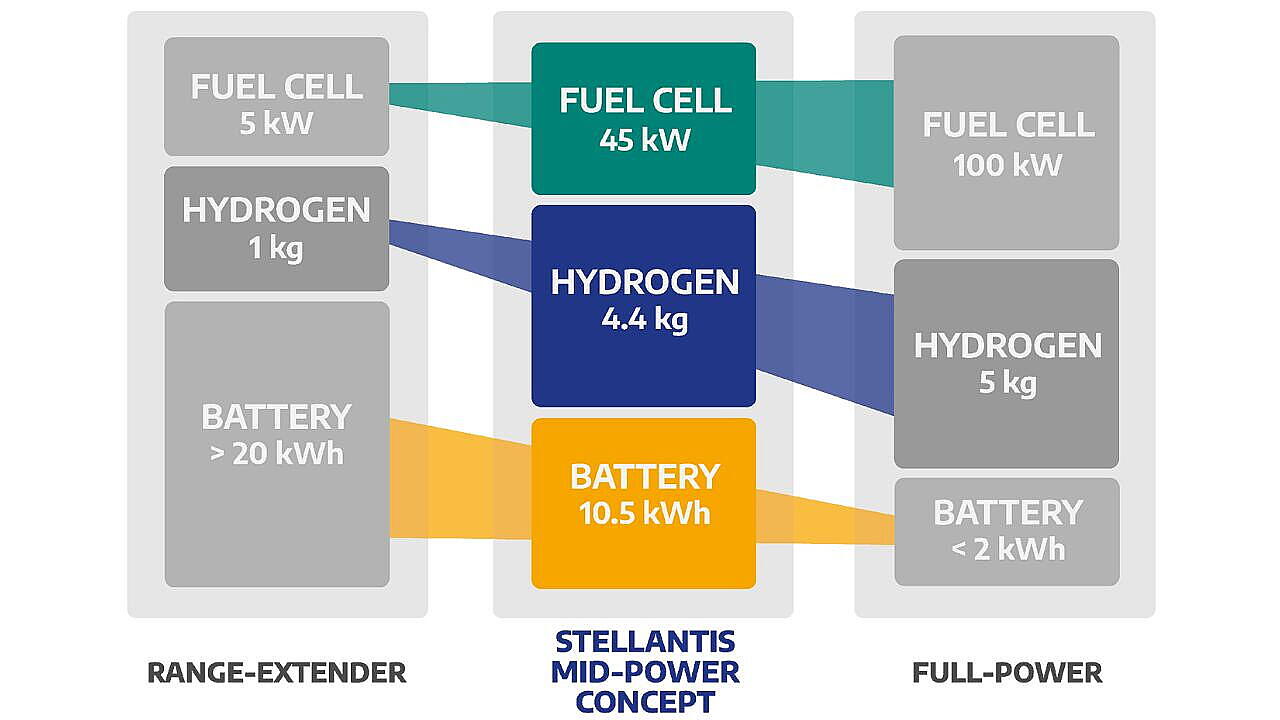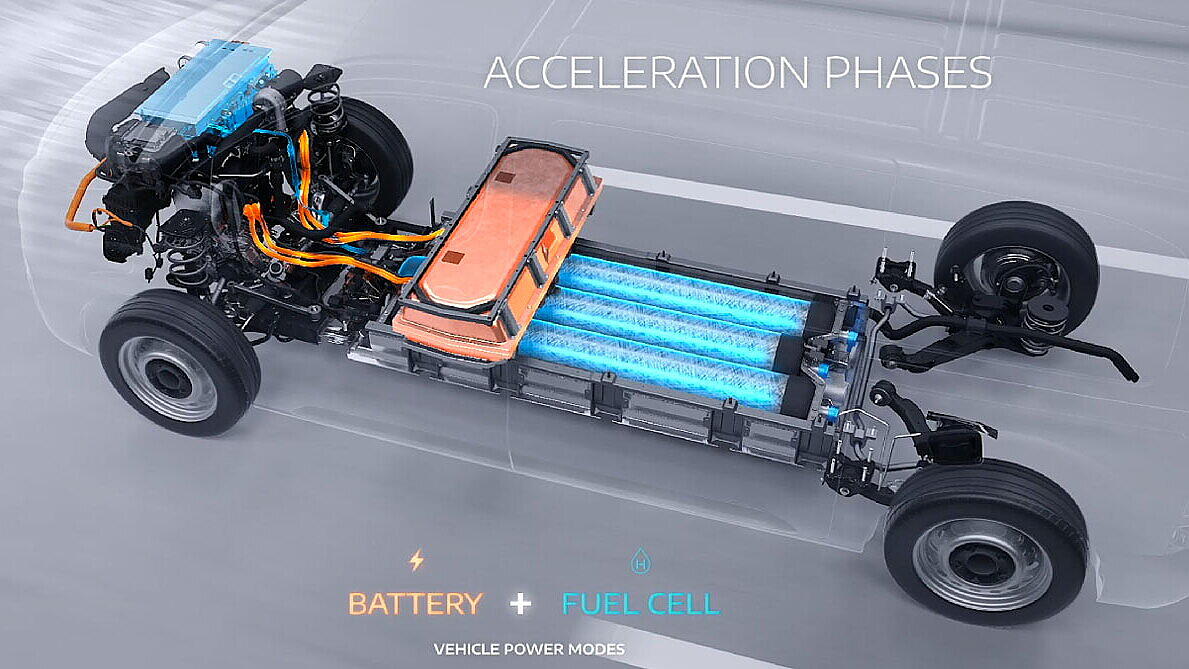
As part of its initiative to address the widest range of mobility requirements, especially beyond electrification, the leading automakers and a mobility provider, Stellantis is stepping its gas in pushing its agenda on the broad spectrum of energy carriers and powertrain technologies, including hydrogen.
Stellantis has developed a Hydrogen Fuel Cell Zero-Emission solution, amalgamating the goodness of hydrogen fuel cells and battery electric technology, in a Fuel Cell Electric Vehicle (FCEV). Suited to the needs of light commercial vehicles (LCV) where customers require long-range, fast re-fuelling and zero-emissions while not compromising on payload capacity, the carmaker developed a mid-power architecture solution; the innovative technology delivers a range of more than 400 kilometres while refuelling in just three minutes, which is almost the same time of refuelling diesel. Hydrogen provides the energy needed for an extended driving range, while a medium-capacity battery provides the power for dynamic performance, energy recovery, and plug-in capability.
Innovative Design
To ensure the same payload, the designers made sure that the components relating to the fuel cell propulsion system have been placed away from the cargo loading space. Furthermore, the system can also be integrated with its existing battery-electric LCV platform. Therefore, the set objectives of minimum variation and maximum synergies are accomplished between the full battery-electric vehicles and the hydrogen versions.

By combining hydrogen and air in the presence of a catalyst, the fuel cell generates electricity to drive an electric motor, with water vapour as the only by-product. So, compared to a battery, a fuel cell is an energy converter rather than a storage device. As a result, fuel cell electric vehicle architectures range from a ‘full-power’ configuration at one end of the spectrum to a ‘range-extender’ configuration at the other.
Max Power, Extended Range
The fuel cell is the main source of propulsion under all operating conditions. This requires a large and powerful fuel cell and a small battery. A battery-electric vehicle with a large battery is combined with a small, low-power fuel cell that extends the range of the vehicle by supplying power to the battery. However, the fuel cell cannot generate enough power to propel the vehicle when the battery is fully discharged. Since a mid-power fuel cell is also mid-size, the entire system can be integrated with existing battery-electric LCV production models. The designers replaced the traction battery with three storage tanks that provide hydrogen to the fuel cell system.
Nix Modifications
The unique design converts a battery-electric LCV into a fuel cell electric LCV without modifications to the body. Therefore, there is no impact on cargo space or payload while offering a range of more than 400 km based on the Worldwide Harmonised Light Vehicle Test Procedure (WLTP) cycle, which aims to provide CO₂ emissions and fuel economy data that is closer to real-world figures than the previous test.
The fuel cell system can provide enough power for continuous highway speed. When needed, peak power is provided by the battery positioned under the front seats. Interestingly, the battery is a carry-over component from its existing plug-in hybrid electric vehicle programme.
The battery covers power requirements for acceleration and other functions, as well as start-up and first mile, providing better durability than a full-power system. It is achieved by allowing the fuel cell system to run at optimum operating conditions. In addition, the battery enables regenerative braking, the promising benefit of hybrid systems. The plug-in capability also allows the battery to be recharged from an external power source providing a pure battery-electric range of 50 km.
Stellantis Hordain
Stellantis holds several products and services, including Abarth, Alfa Romeo, Chrysler, Citroën, Dodge, DS Automobiles, Fiat, Jeep, Lancia, Maserati, Opel, Peugeot, Ram, Vauxhall, Free2move and Leasys. Stellantis CEO Carlos Tavares visited the Hordain site in the northern Hauts-de-France region recently. After his tour around the facility, he announced the company's intent to get in to mass production of Peugeot, Citroën and Opel light commercial vehicles in hydrogen-powered versions equipped with a fuel cell.
According to Tavares, the mass production announcement demonstrates the vehicle maker’s commitment to investing in France in the latest technologies and supporting low-carbon mobility based on the ‘One Company’ principle. “Stellantis has succeeded in moving on to the next step in automotive history, in a transition managed in conjunction with our social partners at our 12 industrial sites across seven French regions, where we are proud to have laid historical roots.”

Multiple Energy Line
These hydrogen-powered vehicles will be assembled on the site’s multi-energy line, which already produces the electric and combustion engine versions of the ‘K-Zero.' Using a reinforced platform from body-in-white onwards, the hydrogen-powered models will follow the usual paintwork and assembly stages on the same production line as combustion engines and electric vehicles before they enter the new 8,000-square-metre facility that focuses solely on the final tuning.
Dedicated Team
A dedicated team will install the tank, the additional batteries, and the fuel cell on a production line at the Hordain plant, which halves the adjustment time compared to the previous small-scale process, where the fuel cell was assembled at a pilot workshop in Rüsselsheim.
This industrialisation of hydrogen-powered LCV – accompanied by €10 million in investments with financial support from the French Government – is a new step for Hordain, where 43% of models for the Peugeot, Citroën, Opel, Vauxhall, Fiat and Toyota brands are already available in a zero-emission electric version.
The ‘K-zero’ vehicles with a fuel cell are intended for long-distance freight professionals who require a longer range (400 km), the fastest possible charging time (three minutes) and no compromises on charging capacity (1,000 kg of payload).
Inaugurated in 1994, the Hordain facility is one of the key locations of Stellantis commercial vehicles division. This benchmark site assembles LCVs and passenger cars from the K-Zero family. The manufacturing facility produces 628 vehicles a day; the site assembled 144,650 vehicles in 2021.
Also Read:
Stellantis Commissions Software Centre In Bengaluru
Stellantis Invests $99 Mn To Make New Engine At 3 North American Plants
Stellantis Jots Down India’s Role In Dare Forward 2030 Global Strategic Plan